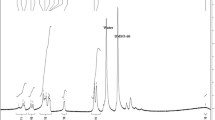Abstract
By the nucleophilic substitution of the nitro group in 4-nitrophthalononitrile for the residues of alkoxy-substituted phenols, the synthesis of alkoxyphenoxyphthalonitriles was carried out. By template condensation of the substituted phthalonitriles obtained with copper and cobalt acetates at 200 °C, the corresponding phthalocyaninates were obtained. The conditions for the isolation and purification of the complexes synthesized were selected. The stability of substituted phthalonitriles and phthalocyaninates synthesized based on them regarding to heating in an argon–oxygen medium was evaluated (1:1 ratio). It was found the compounds obtained are thermally stable, and the destruction of phthalocyanines begins at lower temperatures compared to the corresponding phthalonitriles. For the complexes synthesized, the spectroscopic properties in organic solvents and concentrated sulfuric acid were studied. The influence of the nature of the substituent, metal complexing agent and solvent on the nature of the spectroscopic curves and the position of the main absorption band of phthalocyanine complexes has been established. It is noted passing from polar aprotic solvents to nonpolar ones, a shift of the maximum of the Q absorption band for the studied macrocycles was observed. Electronic absorption spectra in sulfuric acid show a significant bathochromic shift of the absorption band. An increase in the length of the alkyl substituent practically was found not to affect the position of the absorption maximum. Passing from complexes with Co(II) to Cu(II), a bathochromic shift of the absorption maximum was observed.








Similar content being viewed by others
References
Jilani BS, Mruthyunjayachari CD, Malathesh P, Mounesh Sharankumar TM, Reddy KRV. Electrochemical sensing based MWCNT-cobalt tetra substituted sorbaamide phthalocyanine onto the glassy carbon electrode towards the determination of 2-amino phenol: a voltammetric study. Sens Actuators B Chem. 2019;301:127078. https://doi.org/10.1016/j.snb.2019.127078.
Gorduk S. Synthesis, photophysics and photochemistry studies on non-peripherally tetra-substituted Zn(II) and In(III) phthalocyanines bearing ferulic acid units. J Mol Struct. 2019;1198:126921. https://doi.org/10.1016/j.molstruc.2019.126921.
Deyab MA, Mele G. Polyaniline/Zn-phthalocyanines nanocomposite for protecting zinc electrode in Zn–air battery. J Power Sources. 2019;443:227264. https://doi.org/10.1016/j.jpowsour.2019.227264.
Li X, Zhang T, Chen Y, Fu Y, Su J, Guo L. Hybrid nanostructured copper(II) phthalocyanine/TiO2 films with efficient photoelectrochemical performance. Chem Eng J. 2019;382:122783. https://doi.org/10.1016/j.cej.2019.122783.
Moradian S, Dezhampanah H, Ghasemi JB, Behnejad H. Spectrophotometric-chemometrics study of the effect of solvent composition and temperature on the spectral shape and shift of copper and nickel phthalocyanines in different aqueous-nonaqueous mixed solvents. Spectrochim Acta Part A Mol Biomol Spectrosc. 2020;227:117621. https://doi.org/10.1016/j.saa.2019.117621.
Yakan H, Çavuş MS, Güzel E, Arslan BS, Bakır T, Muğlu H. Phthalocyanines including 2-mercaptobenzimidazole analogs: synthesis, spectroscopic characteristics, quantum-chemical studies on the relationship between electronic and antioxidant properties. J Mol Struct. 2020;1202:127259. https://doi.org/10.1016/j.molstruc.2019.127259.
Boutin E, Wang M, Lin JC, Mesnage M, Mendoza D, Lassalle-Kaiser B, Hahn C, Jaramillo TF, Robert M. Aqueous electrochemical reduction of carbon dioxide and carbon monoxide into methanol with cobalt phthalocyanine. Angew Chemie Int Ed. 2019;58:16172–6. https://doi.org/10.1002/anie.201909257.
Wang M, Torbensen K, Salvatore D, Ren S, Joulié D, Dumoulin F, Mendoza D, Lassalle-Kaiser B, Işci U, Berlinguette CP, Robert M. CO2 electrochemical catalytic reduction with a highly active cobalt phthalocyanine. Nat Commun. 2019;10:3602. https://doi.org/10.1038/s41467-019-11542-w.
Saka ET, Dügdü E, Ünver Y. Degradation of substituted phenols with different oxygen sources catalyzed by Co(II) and Cu(II) phthalocyanine complexes. J Coord Chem. 2019;72:1119–30. https://doi.org/10.1080/00958972.2019.1589461.
Karaca H. Synthesis of novel chalcone substituted metallophthalocyanines electrochemistry. J Turkish. 2018;5:701–18. https://doi.org/10.18596/jotcsa.351559.
Cheng Z, Dai M, Quan X, Li S, Zheng D, Liu Y, Yao R. Synthesis and catalytic activity of activated carbon supported sulfonated cobalt phthalocyanine in the preparation of dimethyl disulfide. Appl Sci. 2018;9:124. https://doi.org/10.3390/app9010124.
Sen P, Managa M, Nyokong T. New type of metal-free and Zinc(II), In(III), Ga(III) phthalocyanines carrying biologically active substituents: synthesis and photophysicochemical properties and photodynamic therapy activity. Inorganica Chim Acta. 2019;491:1–8. https://doi.org/10.1016/j.ica.2019.03.010.
Güzel E, Günsel A, Bilgiçli AT, Atmaca GY, Erdoğmuş A, Yarasir MN. Synthesis and photophysicochemical properties of novel thiadiazole-substituted zinc(II), gallium(III) and silicon(IV) phthalocyanines for photodynamic therapy. Inorganica Chim Acta. 2017;467:169–76. https://doi.org/10.1016/j.ica.2017.07.058.
Günsel A, Güzel E, Bilgiçli AT, Atmaca GY, Erdoğmuş A, Yarasir MN. Synthesis and investigation of photophysicochemical properties of novel ketone-substituted gallium(III) and indium(III) phthalocyanines with high singlet oxygen yield for photodynamic therapy. J Lumin. 2017;192:888–92. https://doi.org/10.1016/j.jlumin.2017.08.014.
Ouyang M, Hu X, Shao X, Chen L, Li W, Bai R, Zhang L, Lv X, Tameev A, Zhang C. In situ preparation and determination of electrochemical and electrochromic properties of copper phthalocyanine-polyaniline nanocomposite films. RSC Adv. 2019;9:34382–8. https://doi.org/10.1039/c9ra06540g.
Yıldız B, Güzel E, Menges N, Şişman I, Şener MK. Pyrazole-3-carboxylic acid as a new anchoring group for phthalocyanine-sensitized solar cells. Sol Energy. 2018;174:527–36. https://doi.org/10.1016/j.solener.2018.09.039.
Yatabe M, Kajitani A, Yasutake M, Discotic OK. Liquid crystals of transition metal complexes, 55: novel chlorine-substituted phthalocyanine derivatives showing mesomorphism and low HOMO energy level. J Porphyr Phthalocyanines. 2018;22:32–45. https://doi.org/10.1142/S1088424617500717.
Göl EY, Karabudak E. Ball-type phthalocyanines: similarities and differences from mono phthalocyanines. Mini Rev Org Chem. 2018;16:410–21. https://doi.org/10.2174/1570193x15666181025110759.
Basova T, Hassan A, Durmuş M, Gürek AG, Ahsen V. Liquid crystalline metal phthalocyanines: structural organization on the substrate surface. Coord Chem Rev. 2016;310:131–53. https://doi.org/10.1016/j.ccr.2015.11.005.
Snow AW. Phthalocyanine aggregation. In: The porphyrin handbook: phthalocyanines: properties and materials. Elsevier, Amsterdam; 2003. p. 129–76. https://doi.org/10.1016/b978-0-08-092391-8.50009-1.
Kobayashi N. Phthalocyanines. Curr Opin Solid State Mater Sci. 1999;4:345–53. https://doi.org/10.1016/S1359-0286(99)00030-3.
Sorokin AB. Phthalocyanine metal complexes in catalysis. Am Chem Soc. 2013;113:8152–91. https://doi.org/10.1021/cr4000072.
Durmus M, Nyokong T. Synthesis and solvent effects on the electronic absorption and fluorescence spectral properties of substituted zinc phthalocyanines. Polyhedron. 2007;26:2767–76. https://doi.org/10.1016/j.poly.2007.01.018.
Acknowledgements
The work was carried out using equipment of Collective Usage Center of ISUCT and was supported by Russian Science Foundation Grant, Project 19-73-10107.
Author information
Authors and Affiliations
Corresponding author
Additional information
Publisher's Note
Springer Nature remains neutral with regard to jurisdictional claims in published maps and institutional affiliations.
Electronic supplementary material
Below is the link to the electronic supplementary material.
Rights and permissions
About this article
Cite this article
Erzunov, D., Tikhomirova, T., Botnar, A. et al. Bulky-substituted phthalodinitriles and cobalt and copper phthalocyanines based on them: synthesis, thermal analysis and spectroscopic properties. J Therm Anal Calorim 142, 1807–1816 (2020). https://doi.org/10.1007/s10973-020-10025-1
Received:
Accepted:
Published:
Issue Date:
DOI: https://doi.org/10.1007/s10973-020-10025-1



